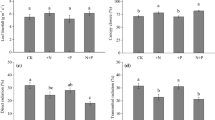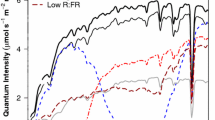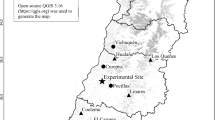Abstract
The effects of moderately elevated ozone (ca. 35 ppb) on the growth and secondary chemistry of the leaves of two soil-grown Finnish hybrid aspen (Populus tremula L. x Populus tremuloides Michx.) clones with different ozone sensitivities were studied at an open-air exposure field in Kuopio, Finland. Stomatal conductance, photosynthetic rate, and chlorophyll fluorescence were measured during the third growing season. Foliar phenolic concentrations, ergosterol concentration of fine roots, and final dry mass of the trees were determined at the end of the third growing season. Elevated ozone increased the ectomycorrhizal status of the fine roots but had no effect on gas exchange or on the final biomass of either of the clones, indicating equal sensitivity to ozone and no effect of elevated ozone on the intraspecific competitive ability of the clones after three growing seasons. However, in agreement with the data from potted plants of the same clones after two growing seasons, significant differences between the clones were found in all parameters measured. A negative correlation between growth and high concentrations of foliar phenolics indicated that allocation to secondary chemistry also was costly in terms of growth under high resource availability.






Similar content being viewed by others
References
Agrell, J., Kopper, B., McDonald, E. P., and Lindroth, R. L. 2005. CO2 and O3 effects on host plant preferences of the forest tent caterpillar (Malacosoma disstria). Global Change Biol. 11:588–599.
Allen, S. E. 1989. Chemical Analysis of Ecological Materials. Blackwell Scientific, London.
Andersen, C. P. 2003. Source-sink balance and carbon allocation below ground in plants exposed to ozone. New Phytol. 157:213–228.
Blande, J. D., Tiiva, P., Oksanen, E., and Holopainen, J. K. 2007. Emission of herbivore-induced volatile terpenoids from two hybrid aspen (Populus tremula x tremuloides) clones under ambient and elevated ozone concentrations in the field. Global Change Biol. 13:2538–2550.
Cabané, M., Pireaux, J., Léger, E., Weber, E., Dizengremel, P., Pollet, B., and Lapierre, C. 2004. Condensed lignins are synthesized in poplar leaves exposed to ozone. Plant Physiol. 134:586–594.
Christersson, L. 2008. Poplar plantations for paper and energy in the south of Sweden. Biomass Bioenergy 32:997–1000.
Donaldson, J. R., Kruger, E. L., and Lindroth, R. L. 2006. Competition- and resource-mediated tredeoffs between growth and defensive chemistry in trembling aspen (Populus tremuloides). New Phytol. 169:561–570.
Geron, C., Harley, P., and Guenther, A. 2001. Isoprene emission capacity for US tree species. Atmos. Environ. 35:3341–3352.
Gershenzon, J. 1994. The cost of plant chemical defense against herbivory: A biochemical perspective, pp. 105, in E. A. Bernays (ed.). Insect-Plant Interactions. CRC, Boca Raton.
Grace, S. C., Logan, B. A., and Adams, W. W. 1998. Seasonal differences in foliar content of chlorogenic acid, a phenylpropanoid antioxidant, in Mahonia repens. Plant, Cell Environ. 21:513–521.
Grebenc, T. and Kraigher, H. 2007. Changes in the community of ectomycorrhizal fungi and increased fine root number under adult beech trees chronically fumigated with double ambient ozone concentration. Plant Biol. 9:279–287.
Grulke, N. E., Andersen, C. P., Fenn, M. E., and Miller, P. R. 1998. Ozone exposure and nitrogen deposition lowers root biomass of ponderosa pine in the San Bernardino Mountains, California. Environ. Pollut. 103:63–73.
Haase, D. L. and Rose, R. 1995. Vector analysis and its use for interpreting plant nutrient shifts in response to silvicultural treatments. Forest Sci. 41:54–66.
Häikiö, E., Freiwald, V., Silfver, T., Beuker, E., Holopainen, T., and Oksanen, E. 2007. Impacts of elevated ozone and nitrogen on growth and photosynthesis of European aspen (Populus tremula) and hybrid aspen (P. tremula x Populus tremuloides) clones. Can. J. For. Res. 37:2326–2336.
Häikiö, E., Freiwald, V., Julkunen-Tiitto, R., Beuker, E., Holopainen, T., and Oksanen, E. 2008. Differences in leaf characteristics between ozone-sensitive and ozone-tolerant hybrid aspen (Populus tremula x P. tremuloides) clones. Tree Phys. 29:53–66.
Hakulinen, J. 1998. Nitrogen-induced reduction in leaf phenolic level is not accompanied by increased rust frequency in a compatible willow (Salix myrsinifolia)—Melampsora rust interaction. Physiol. Plantarum 102:101–110.
Hakulinen, J., Sorjonen, S., and Julkunen-Tiitto, R. 1999. Leaf phenolics of three willow clones differing in resistance to Melampsora rust infection. Physiol. Plantarum 105:662–669.
Hemming, J.D., and Lindroth, R.L. 1999. Effects of light and nutrient availability on aspen: growth, phytochemistry, and insect performance. J. Chem. Ecol. 25:1687–1714.
Hendrick, R. L. and Pregitzer, K. S. 1996. Temporal and depth-related patterns of fine root dynamics in northern hardwood forests. J. Ecol. 84:167–176.
Hermle, S., Vollenweider, P., Günthardt-Goerg, M. S., McQuattie, C. J., and Matyssek, R. 2007. Leaf responsiveness of Populus tremula and Salix viminalis to soil contaminated with heavy metals and acidic rainwater. Tree Phys. 27:1517–1531.
Holton, M. K., Lindroth, R., and Nordheim, E. 2003. Foliar quality influences tree-herbivore-parasitoid interactions: effects of elevated CO2, O3, and plant genotype. Oecologia 137:233–244.
Jordan, D.N., Green, T.H., Chappelka, A.H., Lockaby, B.G., Meldahl, R.S., and Gjerstad, D.H. 1991. Response of total tannins and phenolics in loblolly pine foliage exposed to ozone and acid rain. J. Chem. Ecol. 17:505–513.
Kaakinen, S., Kostiainen, K., Ek, F., Saranpää, P., Kubiske, M. E., Sober, J., Karnosky, D. F., and Vapaavuori, E. 2004. Stem wood properties of Populus tremuloides, Betula papyrifera and Acer saccharum saplings after 3 years of treatments to elevated carbon dioxide and ozone. Global Change Biol. 10:1513–1525.
Karnosky, D. F., Pregitzer, K. S., Zak, D. R., Kubiske, M. E., Hendrey, G. R., Weinstein, D., Nosal, M., and Percy, K. E. 2005. Scaling ozone responses of forest trees to the ecosystem level in a changing climate. Plant Cell Environ. 28:965–981.
Kasurinen, A., Keinänen, M. M., Kaipainen, S., Nilsson, L., Vapaavuori, E., Kontro, M. H., and Holopainen, T. 2005. Below-ground responses of silver birch trees exposed to elevated CO2 and O3 levels during three growing seasons. Global Change Biol. 11:1167–1179.
King, J. S., Pregitzer, K. S., Zak, D. R., Sober, J., Isebrands, J. G., Dickson, R. E., Hendrey, G. R., and Karnosky, D. F. 2001. Fine-root biomass and fluxes of soil carbon in young stands of paper birch and trembling aspen as affected by elevated atmospheric CO2 and tropospheric O3. Oecologia 128:237–250.
King, J. S., Kubiske, M. E., Pregitzer, K. S., Hendrey, G. R., McDonald, E. P., Giardina, C. P., Quinn, V. S., and Karnosky, D. F. 2005. Tropospheric O3 compromises net primary production in young stands of trembling aspen, paper birch and sugar maple in response to elevated atmospheric CO2. New Phytol. 168:623–636.
Kleiner, K. W., Raffa, K. F., Ellis, D. D., and McCown, B. H. 1998. Effect of nitrogen availability on the growth and phytochemistry of hybrid poplar and the efficacy of the Bacillus thuringiensis cry1A(a) d-endotoxin on gypsy moth. Can. J. For. Res. 28:1055–1067.
Kontunen-Soppela, S., Ossipov, V., Ossipova, S., and Oksanen, E. 2007. Shift in birch leaf metabolome and carbon allocation during long-term open-field ozone exposure. Global Change Biol. 13:1053–1067.
Koricheva, J. 1999. Interpreting phenotypic variation in plant allelochemistry: problems with the use of concentrations. Oecologia 119:467–473.
Kubiske, M. E., Quinn, V. S., Marquardt, P. E., and Karnosky, D. F. 2007. Effects of elevated atmospheric CO2 and/or O3 on intra- and interspecific competitive ability of aspen. Plant Biol. 9:342–355.
Luoranen, J., Lappi, J., Zhang, G., and Sõber, A. 2006. Field performance of hybrid aspen clones planted in summer. Silva Fennica 40:257–269.
Markkola, A. M. 1996. Resource allocation in ectomycorrhozal symbiosis in scots pine affected by environmental changes. PhD dissertation. University of Oulu, Oulu.
Miranda, M., Ralph, S. G., Mellway, R., White, R., Heath, M. C., Bohlmann, J., AND Constabel, C. P. 2007. The transcriptional response of hybrid poplar (Populus trichocarpa x P. deltoides) to infection by Melampsora medusae leaf rust involves induction of flavonoid pathway genes leading to the accumulation of proanthocyanidins. Mol. Plant-Microbe Interact. 20:816–831.
Monson, R. K. and Fall, R. 1989. Isoprene emission from aspen leaves. Plant Physiol. 90:267–274.
Neville, J., Tessier, J. L., Morrison, I., Scarratt, J., Canning, B., and Klironomos, J. N. 2002. Soil depth distribution of ecto- and arbuscular mycorrhizal fungi associated with Populus tremuloides within a 3-year-old boreal forest clear-cut. Appl. Soil Ecol. 19:209–216.
Nylund, J. and Wallander, H. 1992. Ergosterol analysis as a means of quantifying mycorrhizal biomass. Meth. Microbiol. 24:77–88.
Oksanen, E., Amores, G., Kokko, H., Santamaria, J. M., and Kärenlampi, L. 2001. Genotypic variation in growth and physiological responses of Finnish hybrid aspen (Populus tremuloides x P. tremula) to elevated tropospheric ozone concentration. Tree Physiol. 21:1171–1181.
Olsson, P. A., Larsson, L., Bago, B., Wallander, H., and Van Aarle, I. M. 2003. Ergosterol and fatty acids for biomass estimation of mycorrhizal fungi. New Phytol. 159:7–10.
Osier, T. L. and Lindroth, R. L. 2001. Effects of genotype, nutrient availability, and defoliation on aspen phytochemistry and insect performance. J. Chem. Ecol. 27:1289–1313.
Osier, T. and Lindroth, R. 2006. Genotype and environment determine allocation to and costs of resistance in quaking aspen. Oecologia 148:293–303.
Peltonen, P. A., Vapaavuori, E., and Julkunen-Tiitto, R. 2005. Accumulation of phenolic compounds in birch leaves is changed by elevated carbon dioxide and ozone. Global Change Biol. 11:1305–1324.
Porter, L. J., Hrstich, L. N., and Chan, B. G. 1986. The conversion of procyanidins and prodelphinidins to cyanidin and delphinidin. Phytochemistry 25:223–230.
Pregitzer, K. S., Deforest, J. L., Burton, A. J., Allen, M. F., Ruess, R. W., and Hendrick, R. L. 2002. Fine root architecture of nine North American trees. Ecol. Monogr. 72:293–309.
Pregitzer, K. S., Burton, A. J., King, J. S., and Zak, D. R. 2008. Soil respiration, root biomass, and root turnover following long-term exposure of northern forests to elevated atmospheric CO2 and tropospheric O3. New Phytol. 180:153–161.
Rytter, L. and Stener, L. 2005. Productivity and thinning effects in hybrid aspen (Populus tremula L. x P. tremuloides Michx.) stands in southern Sweden. Forestry 78:285–295.
Saleem, A., Loponen, J., Pihlaja, K., and Oksanen, E. 2001. Effects of long-term open-field ozone exposure on leaf phenolics of European silver birch (Betula pendula Roth). J. Chem. Ecol. 27:1049–1062.
Salmanowicz, B. and Nylund, J. 1988. High performance liquid chromatography determination of ergosterol as a measure of ectomycorrhiza infection in Scots pine. Eur. J. Forest Pathol. 18:291–298.
Smith, S. E. and Read, D. J. 1997. Mycorrhizal Symbiosis. Academic, San Diego, CA.
The Royal Society. 2008. Ground-level ozone in the 21st century: future trends, impacts and policy implications. RS Policy document15/08. The Royal Society, London. <http://royalsociety.org/displaypagedoc.asp?id=31506>
Tsai, C., Harding, S. A., Tschaplinski, T. J., Lindroth, R. L., and Yuan, Y. 2006. Genome-wide analysis of the structural genes regulating defense phenylpropanoid metabolism in Populus. New Phytol. 172:47–62.
Tullus, A., Tullus, H., Vares, A., and Kanal, A. 2007. Early growth of hybrid aspen (Populus x wettsteinii Hämet-Ahti) plantations on former agricultural lands in Estonia. Forest Ecol. Manage. 245:118–129.
Valkama, E., Koricheva, J., and Oksanen, E. 2006. Effects of elevated O3, alone and in combination with elevated CO2, on tree leaf chemistry and insect herbivore performance: a meta-analysis. Global Change Biol. 12:1–18.
Wittig, V. E., Ainsworth, E. A., and Long, S. P. 2007. To what extent do current and projected increases in surface ozone affect photosynthesis and stomatal conductance of trees? A meta-analytic review of the last 3 decades of experiments. Plant Cell Environ. 30:1150–1162.
Yu, Q. and Pulkkinen, P. 2003. Genotype-environment interaction and stability in growth of aspen hybrid clones. For. Ecol. Manage. 173:25–35.
Yu, Q., Tigerstedt, P. M. A., and Haapanen, M. 2001. Growth and phenology of hybrid aspen clones (Populus tremula L. x Populus tremuloides Michx.). Silva Fenn. 35:15–25.
Zak, D. R., Holmes, W. E., Pregitzer, K. S., King, J. S., Ellsworth, D. S., and Kubiske, M. E. 2007. Belowground competition and the response of developing forest communities to atmospheric CO2 and O3. Global Change Biol. 13:2230–2238.
Zsuffa, L., Giordano, L., Pryor, L. D., and Stettler, R. F. 1996. Trends in poplar culture: Some global and regional perspectives, pp. 515, in R. F. Stettler, H. D. J. Bradshaw, P. E. Heilman, and T. M. Hinckley (eds.). Biology of Populus and Its Implications for Management and Conservation. NRC Research, Ottawa, Ontario, Canada.
Acknowledgements
This study was funded by the Academy of Finland project 51758 (E. H. and M. M.), North Savo Regional Fund of the Finnish Cultural Foundation (E. H.), Jenny and Antti Wihuri Foundation (E. H.), the Graduate School in Forest Science (V. F.), Finnish Cultural Foundation (T. S.), and the Academy of Finland project 106538 (V. P.). We thank Timo Oksanen for ozone fumigations and technical assistance, Vesa Kiviniemi for statistical advice, and Dr. Minna Kivimäenpää for valuable comments on the manuscript.
Author information
Authors and Affiliations
Corresponding author
Rights and permissions
About this article
Cite this article
Häikiö, E., Makkonen, M., Julkunen-Tiitto, R. et al. Performance and Secondary Chemistry of Two Hybrid Aspen (Populus tremula L. x Populus tremuloides Michx.) Clones in Long-Term Elevated Ozone Exposure. J Chem Ecol 35, 664–678 (2009). https://doi.org/10.1007/s10886-009-9644-2
Received:
Revised:
Accepted:
Published:
Issue Date:
DOI: https://doi.org/10.1007/s10886-009-9644-2




